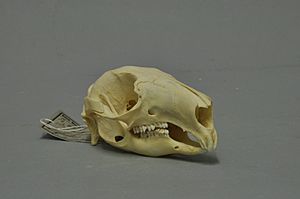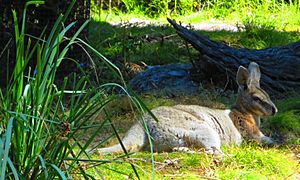Bridled nail-tail wallaby facts for kids
Quick facts for kids Bridled nail-tail wallaby |
|
|---|---|
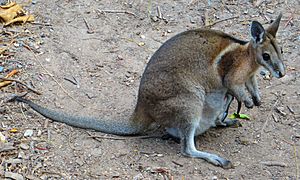 |
|
| Female bridled nail-tail wallaby (Onychogalea fraenata) with a joey in its pouch at David Fleay Wildlife Park, Burleigh Heads, Queensland | |
| Conservation status | |
| Scientific classification | |
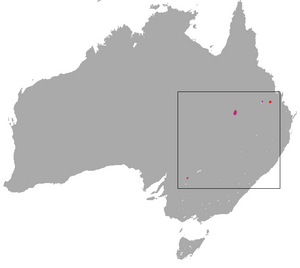 |
The bridled nail-tail wallaby (Onychogalea fraenata) is a special type of macropod, which is a group of animals that includes kangaroos and wallabies. It is also known as the bridled wallaby or flashjack.
This small wallaby is considered a vulnerable species, meaning its population is decreasing and it could become endangered. You can find them in only three small areas in Queensland, Australia. There are fewer than 500 adult wallabies left in the wild, but about 2285 live in places like zoos.
Contents
What Does the Bridled Nail-tail Wallaby Look Like?
These wallabies get their name from two unique features. They have a white "bridle" line that goes from the back of their neck, over their shoulders, and down their sides. They also have a small, hard spur, like a tiny nail, on the end of their tail.
Other features include a black stripe running down their back between their shoulders. They have large eyes and white stripes on their cheeks, which are common in many wallaby species.
A bridled nail-tail wallaby can grow to be about one metre (about 3 feet) long, with half of that length being its tail. They usually weigh between 4 and 8 kilograms (about 9 to 18 pounds). Females are a bit smaller than males. The tail spur is tiny, only 3 to 6 millimetres long, and is partly covered in fur. Scientists are not sure what its exact purpose is.
The "nail-tail" is a feature shared with two other wallaby species: the northern nail-tail wallaby and the crescent nail-tail wallaby. Sadly, the crescent nail-tail wallaby was declared extinct in 1956.
Where Do They Live?
When Europeans first came to Australia, bridled nail-tail wallabies were very common. They lived all along the eastern coast, west of the Great Dividing Range. In the 1800s, naturalists reported seeing them from Victoria all the way up through New South Wales to Queensland.
However, their numbers dropped sharply in the late 1800s and early 1900s. From 1937 to 1973, no one saw any, and many thought they were extinct. But then, a fencing contractor read an article about Australia's extinct animals. He remembered seeing some wallabies on a property near Dingo, Queensland. Researchers later confirmed his sighting! This property eventually became Taunton National Park, a special nature reserve created to protect these rare wallabies.
Today, the bridled nail-tail wallaby lives in less than 5% of the area it used to call home.
Daily Life and Habits
These wallabies are mostly active at night and during dusk (evening). During the day, they usually sleep in hollows near bushes or trees. In areas where they live now, they tend to stay close to the edges of grassy fields.
Bridled nail-tail wallabies are known for being shy and usually prefer to be alone. Sometimes, if there isn't much food, small groups of up to four wallabies might gather to eat together.
When they feel threatened, they try to avoid a fight. Their main ways to stay safe are by hiding in hollow logs or crawling under low shrubs. If they are caught out in the open, they might try to stay completely still, hoping that no one will notice them.
Life Cycle
After about 23 days, a baby wallaby, called a joey, is born. This tiny joey then crawls into its mother's pouch. It stays there and continues to grow for about four more months.
Scientists are very interested in the bridled nail-tail wallaby because it seems to have a very strong immune system. This means they are better at fighting off infections, viruses, and diseases than many other marsupials.
Helping the Bridled Nail-tail Wallaby
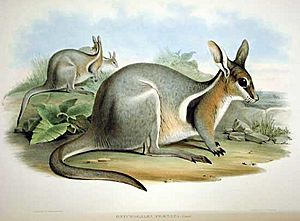
Since their rediscovery, many people have been working hard to help the bridled nail-tail wallaby. They want to create new, healthy populations of these animals.
Special breeding programs have helped create three new groups of wallabies. Two of these groups live in State reserves: Idalia and Taunton National Park. Another group lives on a private reserve called Project Kial near Marlborough. Sadly, the re-introduction at Idalia didn't work out. So now, the wallabies are mainly found in three places: Taunton National Park, Avocet Nature Refuge, and Scotia Sanctuary. As mentioned before, there are fewer than 500 adult wallabies left in the wild.
In the early 1900s, many of these wallabies were hunted for their fur or because people thought they were pests. Today, the biggest dangers to them are introduced animals like feral cats, red foxes, and dingoes, which hunt them. Other threats include wildfires, long periods without rain (drought), and their homes being destroyed by farming. They also have to compete for food with other grazing animals like rabbits and sheep.
See also
 In Spanish: Walabí de bridas para niños
In Spanish: Walabí de bridas para niños



